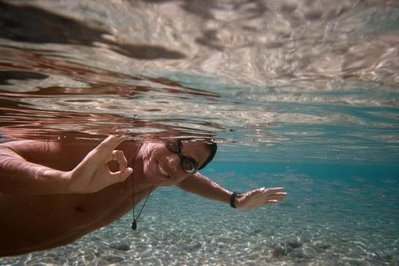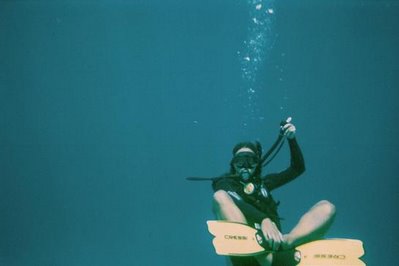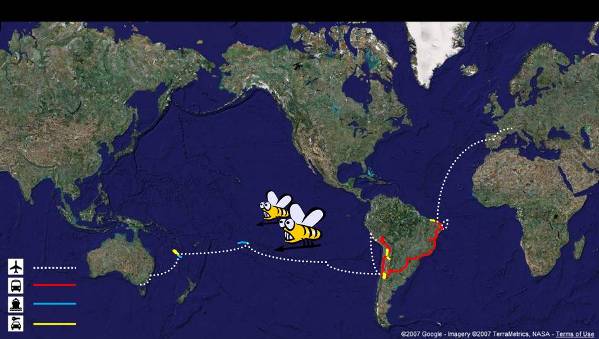
First of all, it's planning our budget. Since we want to travel at least 10 months before getting to Australia, we have a daily budget of 80 US$ for 2 persons a day, including accommodation, food and local transportation. Now Fernando de Noronha is a typical honey-moon destination completely out of our margins... But as we are real globetrotters, we'll show you how we master that! At first, neglect all commercial packages proposed on mainland and find a low-budget charter, then - on arrival at the destination - hitchhike to the main village and bargain the cheapest bed&breakfast (assure a good quality breakfast as it will have to hold for the day), maintain a special diet and only eat out at after sunset (daytime is short at the equator) and especially never forget to constantly drink enough against dehydration (careful, water is nearly as expensive as 40% alcoholic cachaça, but has a fairly more neutral effect under the sun).
This is not all. A lot of patience is required, and a lot of fortune as well. Lucky enough Anh-Dao has it ;-) (lucky enough Padi normally adapts...). 29 hours before our preferred departure time, we recieved our flight tickets. The story is, that 2 weeks before we had tried to buy those tickets via internet, but we only had managed via a intermediate agent who needed to pass twice himself at Natal airport for us to pay with his local credit card. So much about Brazil's low cost carriers for Brazilians...
Yeah, our feet finally on the ground of Brazil's Hawaii called Fernando de Noronha, a 17 sqkm island with 200 Pousada's and an exorbitant tourist tax fee (for some kind of sustainable tourism program...), we let off our gear in the cheapest Pousada and looked out for the closest beach. Wow! Never seen that before!!! Perfect 3m tubes from a North-Atlantic swell breaking onto an out-of this world picturesque sandbay, surrounded by the dark vulcanic needle Morro do Pico (probably the master of all those famous stone-sculptures of Easter Island) and the transparent, all the way to the northern horizon glassy blue Ocean. Too much? No, sure not for 7 days of Valentine's to come... Feel like dreaming along? Read on!
The other bays to the North and to the South are also of extraordinary beauty, both above and under water (with often over 30m visibility). Imagine nurseries of thousands of baby-fishes in natural pools formed by volcanic rocks only revealed at low-tide. If you manage to wake up at 4:30 AM and start a 6km walk at moonlight, you will be the first to discover hundreds of spinner dolphins in their preferred and protected bay, secluded by 60m high cliffs. You can also spend a night on the beach and wait for the huge turtles, that come on land to lay their eggs (fair enough, we only found their traces the other morning...). There's much effort (and business) done by government programs to preserve those little and big beasts on this paradise-like island.
We admit having most enjoyed the few spinner dolphins playing in the drought of the boat on the way to our scuba-dive sites. The most well-known site is called "Pedras Secas" and presents colourful, moonlike submarine sceneries with caves playing magic with the sunlight and supposedly frequent visits of big animals. We were lucky to see two beautiful, 2.5m large but inoffensive nurse sharks. During our other dives, we saw a white spotted ray flying over a sandy landscape, sea-snakes coloured like leopards and plenty of olive turtles scratching their backs on the rocks. 
On lifting our view back up to the surface at the occurring sound of a motorboat, we smiled at a group of snorkellers, who seemed to be suffering the stinky Diesel air being pulled like fresh bait for the other kinds of shark we did not encounter...
Safe and sound, our memory filled with amazing sunset pictures and the residuels of batido de coco and cachaça, we flew back to the civilization of Mainland-Brazil, now getting crazy for carnival. Olinda, known for it's extravaganza, it's folias in the tiny cobble-stone streets of the colonial-style old town, was our choice to realize a perfect contrast.
Our photo set provides a selection of our own shots with the cell phone's cam and an aquatic throw-away camera. Since our digital camera has been stolen in Canoa Quebrada, we advice you to have a look at this fantastic website of a photographer called Alex Uchoa ! Ok, after depressedly having viewed those artistic pictures of the stunning sites we'd seen with our own eyes, we believe it's better we don't replace our camera throughout the rest of our trip in Brazil. It's easier to click around on internet... or what do you think?



0 Comments:
Post a Comment
<< Home